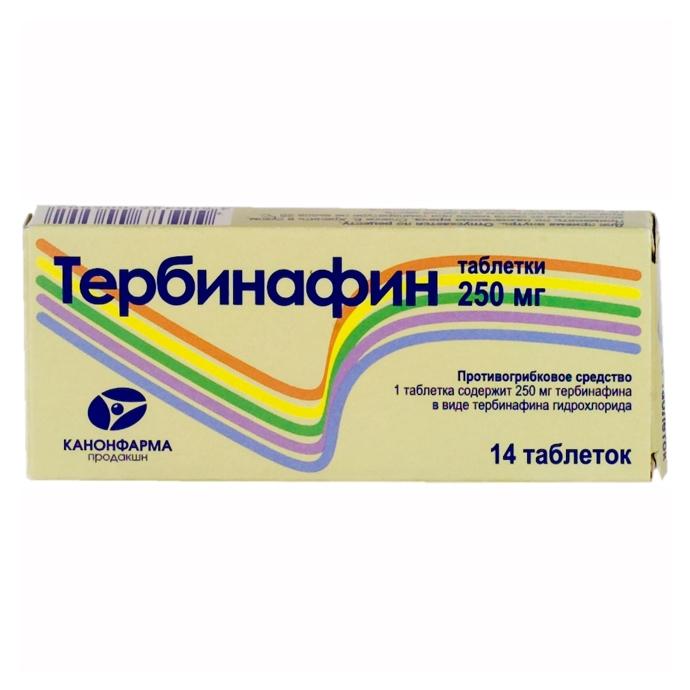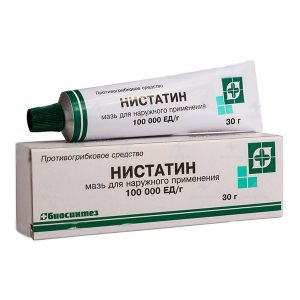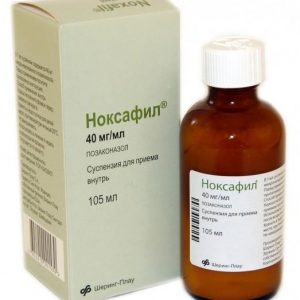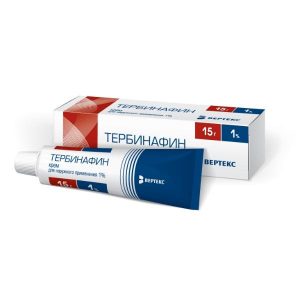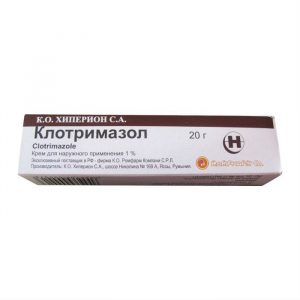Description
packaging 14 pcs
Pharmacological action
Terbinafine is an antifungal agent. It has a wide spectrum of action against fungi that cause diseases of the skin, hair and nails, including dermatophytes, such as Trichophyton (e.g. T. rubrum, T. mentagrophytes, T. verrucosum, T. tonsurans, T. violaceum), Microsporum (e.g. M. canis), Epidermophyton floccosum
yeast of the genus Candida (e.g. C. albicans) and Pityrosporum.
In low concentrations, terbinafine has a fungicidal effect on dermatophytes, molds and some dimorphic fungi. Activity against yeast fungi, depending on their type, can be fungicidal or fungistatic.
The mechanism of action is associated with a specific suppression of the early stage of sterol biosynthesis in the fungal cell. This leads to a deficiency of ergosterol and to intracellular accumulation of squalene, which causes the death of the fungal cell. The action of terbinafine is carried out by inhibiting the enzyme squalene epoxidase in the cell membrane of the fungus. This enzyme does not belong to the cytochrome P450 system. Terbinafine does not significantly affect the metabolism of hormones or other drugs.
Pharmacokinetics
When prescribing terbinafine orally in the skin, hair and nails, drug concentrations are created that provide a fungicidal effect.
After a single oral administration of terbinafine in a dose of 250 mg, its maximum plasma concentration is reached after 2 hours and is 0.97 mcg / ml. The half-absorption period is 0.8 hours, and half-life is 4.6 hours. Although the bioavailability of terbinafine varies moderately under the influence of food, but not to the extent that dose adjustment is required.
Terbinafine binds significantly to plasma proteins (99%). It quickly penetrates the dermal layer of the skin and concentrates in the lipophilic stratum corneum. Terbinafine also penetrates the secretion of the sebaceous glands, which leads to the creation of high concentrations in the hair follicles, hair and in the skin, rich in sebaceous glands. Terbinafine has also been shown to penetrate the nail plates in the first few weeks after starting therapy.
Terbinafine is metabolized rapidly and substantially with the participation of at least seven isoenzymes of cytochrome P450, with the major role played by the isoenzymes CYP2C9, CYP1A2, CYP3A4, CYP2C8 and CYP2C19. As a result of the biotransformation of terbinafine, metabolites are formed that do not have antifungal activity and are excreted mainly in the urine. The final half-life is 17 hours. There is no evidence of cumulation of the drug in the body. No changes in the equilibrium concentration of terbinafine in plasma depending on age were found, but in patients with impaired renal or hepatic function, the rate of excretion of the drug may be slowed, which leads to higher concentrations of terbinafine in the blood.
With topical application of a spray or cream, less than 5% of the dose is absorbed, thus, the systemic effect of the drug is minimal.
Indications
Mycosis of the scalp (trichophytosis, microsporia).
Fungal diseases of the skin and nails (onychomycosis) caused by Trychophyton (T. rubrum, T. mentagrophytes, T. verrucosum, T. violaccum), Microsporum (M. canis, M. gypseum) and Epidermophyton floccosum.
Severe, common dermatomycosis of smooth skin of the trunk and extremities, requiring systemic treatment.
Candidiasis of the skin and mucous membranes.
Contraindications
Hypersensitivity, severe hepatocellular and renal failure, blood diseases, tumors, metabolic diseases, vascular pathology of the extremities, pregnancy, breast-feeding, children (up to 2 years).
Special instructions
Irregular use of terbinafine or premature discontinuation of treatment can lead to a relapse of the disease. If after 2 weeks of treatment for a skin infection, there is no improvement, it is necessary to re-determine the causative agent of the disease and its sensitivity to the drug. Systemic use for onychomycosis is justified only in the case of damage to most nails, the presence of severe subungual hyperkeratosis, and the ineffectiveness of previous local therapy. In the treatment of onychomycosis, a clinical laboratory-confirmed response is usually observed a few months after mycological cure and cessation of treatment, due to the rate of growth of a healthy nail. Removal of nail plates in the treatment of onychomycosis of the hands for 3 weeks and onychomycosis of the feet for 6 weeks is not required.
In the presence of liver disease, terbinafine clearance may be reduced. During treatment, it is necessary to monitor the activity indicators of ² Ñliver ² Ñ transaminases in the blood serum.
In rare cases, after 3 months of treatment, cholestasis and hepatitis occur. If there are signs of impaired liver function (weakness, persistent nausea, decreased appetite, excessive abdominal pain, jaundice, dark urine, or discolored feces), the drug should be discontinued.
Prescribing terbinafine to psoriasis patients requires caution, as in very rare cases, terbinafine can trigger an exacerbation of psoriasis. In the treatment with terbinafine, general hygiene rules should be followed to prevent the possibility of reinfection through underwear and shoes. In the treatment process (after 2 weeks) and at the end it is necessary to produce antifungal treatment of shoes, socks and stockings.
Composition
1 tablet contains:
Active ingredient: terbinafine hydrochloride 250 mg
Excipients: microcrystalline cellulose, hyprolose (hydroxypropyl cellulose), croscarmellose sodium, silicon colloidal dioxide, calcium stearate, lactose monohydrate
Dosage and administration of
Duration of treatment depends on the indication and severity of the disease.
Children: Inside, after food, appoint once a day. A single dose depends on body weight and is: for children with body weight less than 20 kg – 62.5 mg (half a tablet of 125 mg) from 20 to 40 kg – 125 mg (one tablet of 125 mg) more than 40 kg – 250 mg (two 125 mg tablets).
Adults: 250 mg once daily in the evening or 2 times daily 125 mg.
Skin infections:
Recommended treatment duration:
dermatomycosis of the feet (interdigital, plantar, or sock type): 2-6 weeks
dermatomycosis of the trunk, limbs, lower legs: 2-4 weeks
candidiasis of the skin: 2-4 weeks.
Complete disappearance of the manifestations of infection and complaints associated with it can occur only a few weeks after mycological cure.
Infections of the hair and scalp:
Recommended duration of treatment: mycosis of the scalp: 4 weeks.
Mycoses of the scalp are observed mainly in children.
Onychomycosis:
The duration of effective treatment in most patients is from 6 to 12 weeks. With onychomycosis of the hands in most cases, 6 weeks of treatment are sufficient. With onychomycosis of the feet in most cases, 12 weeks of treatment are sufficient. Some patients who have a reduced nail growth rate may require longer treatment. The optimal clinical effect is observed several months after mycological cure and cessation of therapy. This is determined by the period of time that is necessary for the growth of a healthy nail.
The use of terbinafine in the elderly: There is no reason to assume that for the elderly it is necessary to change the dosage of the drug or that they have side effects that are different from those in younger patients. In the case of the use of the drug in tablets in this age group, the possibility of concomitant impaired liver or kidney function should be considered.
Side effects
Sensation of heaviness and pain in the epigastric region, taste disturbance, loss of appetite, nausea, diarrhea, cholestasis, neutropenia, thrombocytopenia, skin allergic reactions, burning sensation, skin redness and itching in the area of application of the cream.
Drug Interactions
A dose adjustment of terbinafine is required when used with inhibitors and inducers of cytochrome P450 isoenzymes, which can slow down and accelerate the excretion of terbine. Cimetidine decreases terbinafine excretion rate by 30%, and rifampicin increases terbinafine excretion rate by 100%. In vitro and in vivo studies have shown that terbinafine, by inhibiting the CYP2P6 isoenzyme, disrupts the metabolism of tricyclic antidepressants, selective serotonin reuptake inhibitors (desipramine, fluvoxamine), beta-blockers (metoprolol, propranolol), antiarrhythmic drugs, flecainin, monoamine oxidase B inhibitors (selegiline) and antipsychotics (chlorpromazine, haloperidol). Terbinafine does not significantly affect the excretion rate of tolbutamine, terfinadine, triazolam, oral contraceptives, which are metabolized using other isoenzymes of cytochrome P450 (except for the isoenzyme CYP2P6). Terbinafine does not affect the excretion rate of antipyrine and digoxin. With the simultaneous administration of terbinafine and oral contraceptives, a menstrual cycle may develop. Terbinafine can enhance the effectiveness of caffeine by increasing its concentration in plasma and reducing the rate of excretion from the body by 21%. Terbinafine can reduce the rate of excretion of desipramine from the body by 82%. Terbinafine can reduce the effectiveness of cyclosporine, by reducing its concentration in plasma by 15%. With simultaneous use with warfarin, it can affect the parameters of the prothrombin test: blood coagulation time and the international normalized ratio. When combined with ethanol or drugs with a hepatoxic effect, there is a risk of drug damage to the liver.
Overdose
Symptoms: nausea, vomiting, headache, dizziness, gastralgia, increased urination, rash.
Treatment: gastric lavage followed by activated charcoal. If necessary, conduct symptomatic therapy.
Storage conditions
Do not store above 25 ° C.
Shelf life
3 years
Active ingredient
Terbinafine
Terms and conditions
prescription
dosage form
tablets
Possible product names
TERBINAFIN 0.25 N14 TABLE
TERBINAFIN 250MG. No. 14 TAB. / CANONFARMA /
TERBINAFIN TAB. 250MG No. 14
Terbinafine tab. 250 mg N14 Russia
Terbinafine tablets 250 mg 14 pcs.
Canonfarma, Russia
